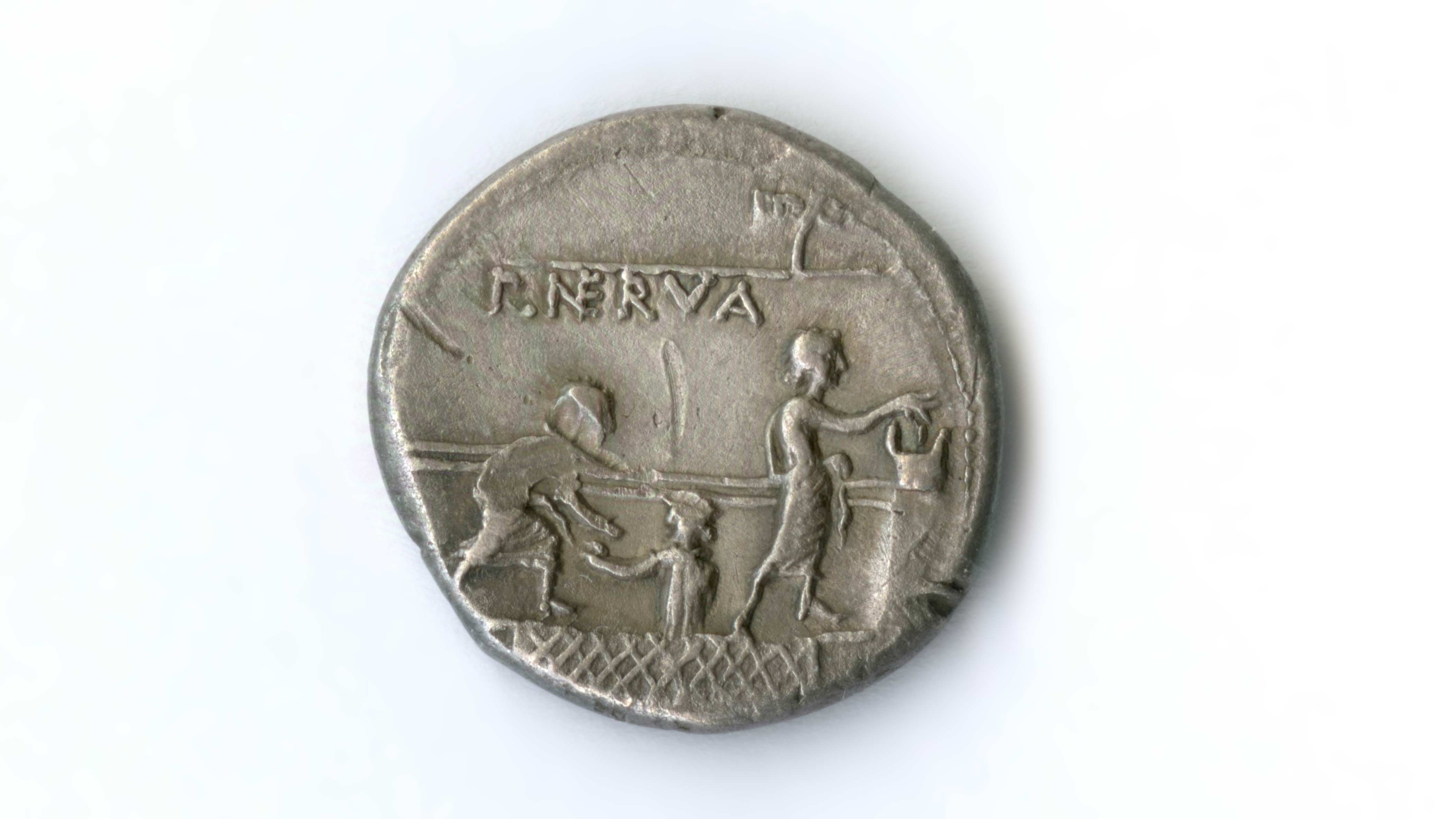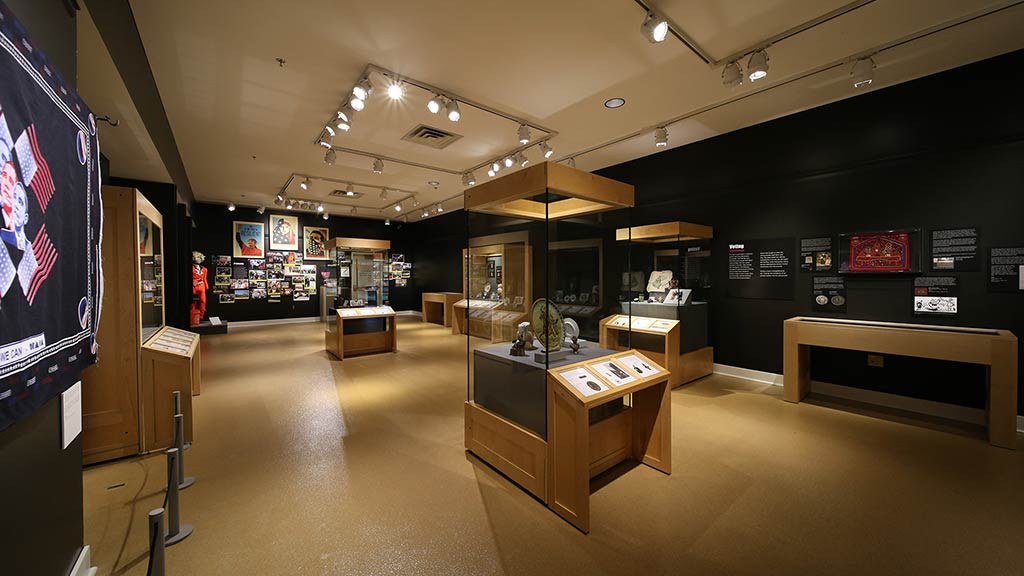
Tablets, Levers, and Paper: How our voting machinery has evolved
- Post Date: 2/3/2021
- Author: Matthew Mayton, registration assistant; Katya Reno, marketing and communications coordinator
- Reading Time: 9 minute read
Lately, many of us have been thinking about—with renewed interest or even for the first time—the logistics of voting. Looking back on the technologies that have supported our democratic processes reveal insights on how different it would have been to fill out a ballot in previous eras. Our current exhibit, Debates, Decisions, Demands: Objects of Campaigns and Activism (Oct. 16, 2020–May 23, 2021), includes many material objects that speak to the voting process and how it has changed over time.
Palm Leaves, Wax Tablets, and “Little Balls”
-
 Coin: Denarius of Rome A Roman coin depicting two men voting. by Licihius Nerva, Moneyer Silver, 1.77cm x .21 cm c 112 BCE 1919.63.0852
Coin: Denarius of Rome A Roman coin depicting two men voting. by Licihius Nerva, Moneyer Silver, 1.77cm x .21 cm c 112 BCE 1919.63.0852
Clay or metal tokens and palm leaves were used to cast votes in some societies. Italians in Medieval Venice voted using small gold or silver balls or ballottas. Ballotta is the Italian word for “little ball,” and it is believed that the term “ballot” comes from this word.
Early societies used various voting systems. In Rome, until 139 BCE, voting was conducted in a public meeting, with eligible citizens casting their vote by shouting their candidate’s name. After 139 BCE, the system turned to secret ballots. Citizens would write the initials of their desired candidate on a wax tablet, which they then would drop into a ballot box, all while under surveillance from a poll-watcher. This Roman coin from our exhibit depicts such a scene.
Paper Ballots
-
 Voters Ballot This ballot, from South Africa’s 1994 election, was a historic moment because prior to the election, the country was run by the apartheid government (1948–1990), which disenfranchised a majority of the population. South Africa paper and ink 1994 Gift of Lynn and Mike Noel 2004.09.0001
Voters Ballot This ballot, from South Africa’s 1994 election, was a historic moment because prior to the election, the country was run by the apartheid government (1948–1990), which disenfranchised a majority of the population. South Africa paper and ink 1994 Gift of Lynn and Mike Noel 2004.09.0001
By the 19th century, paper ballots were in heavy use, but varied greatly. For some ballots, voters wrote their name underneath the name of their chosen candidate; for others, voters provided their own pieces of paper, whether ones they had written on, or ‘tickets’ printed by political parties.
It was not until 1858, in Australia, when the state of Victoria printed, at government expense, a standardized ballot including every candidate’s name. This became known as the “Australian secret ballot.” Since 1858, countries across the world have used some variation of the Australian-style ballot.
The ballots from the 1994 South African national and provincial elections are examples of modern-day Australian-style ballots. The election was a historic moment because prior to the 1994 election, South Africa was run by the apartheid government (1948–1990), which disenfranchised the majority of the population. Non-whites were not allowed to vote in national elections, resulting in only a fraction of the population being eligible. But in this 1994 election, nearly 15 million people were allowed to vote for the first time.
The election lasted 4 days to accommodate the packed polling stations, and in that time nearly 90 percent of the electorate voted. The African National Congress won and installed Nelson Mandela as the first post-apartheid president. Today, in South Africa, April 27 is celebrated as Freedom Day to mark this historic event.
The Lever Voting Machine
-
 Automatic Voting Machine Model Produced by the Automatic Voting Machine Corporation in the 1930s, this particular lever voting machine was probably used to help familiarize voters with how to use a full-size voting machine. The candidate names reflect the 1936 presidential election between Franklin D. Roosevelt and Alf Landon, as well as a 1932 election in Pennsylvania. Paper and metal ca. 1936 from the Automatic Voting Machine Corporation 1992.10.0001
Automatic Voting Machine Model Produced by the Automatic Voting Machine Corporation in the 1930s, this particular lever voting machine was probably used to help familiarize voters with how to use a full-size voting machine. The candidate names reflect the 1936 presidential election between Franklin D. Roosevelt and Alf Landon, as well as a 1932 election in Pennsylvania. Paper and metal ca. 1936 from the Automatic Voting Machine Corporation 1992.10.0001
The lever voting machine was invented by John B. Myers to make voting faster, more accurate, and more honest. It was first used in Lockport, New York in 1892. At that time, the integrity of the vote was sometimes called into question because election officials could “accidentally” tear or mark a ballot to make it invalid, stuff the ballot boxes with additional votes, or throw the entire ballot box into bodies of water. There was a real need for a new voting system, and the lever machine was the high-tech solution of its time.
To use a lever voting machine, voters pulled a large handle, which closed the machine’s curtains to ensure a secret ballot and to unlock the machine. Voters would see a board with candidates’ names, offices, and parties arranged in rows, with small levers above the choices. Once a voter pushed the lever down, the machine locked to prevent a duplicate vote. Voters then pulled back the large handle to reopen the curtains. This reset the small levers and caused an odometer-like device in the machine to turn, casting a single vote for each candidate. The machine was then locked again until the next voter started the process over again.
By the 1940s, 2 companies dominated the manufacturing market: the Shoup Voting Machine Company and the Automatic Voting Machine Corporation. These machines ranged in size and accommodated between 30 to 60 columns or rows for candidates. During this time, most major cities in the US had switched to lever voting machines; however, two-thirds of the country still used paper ballots.
Lever voting machines were not without problems. For one, these machines had thousands of moving parts. They required careful maintenance and were difficult to test. When the last machines were produced in 1982, fixing and replacing worn parts became nearly impossible. Lever voting machines were also not tamperproof: they were vulnerable to the very technicians who were supposed to maintain them. The machines were also inaccessible to voters with physical limitations: the labels with candidates’ names were hard to see, and pulling the levers required strength and mobility. Finally, lever voting machines did not provide an independent record of each vote. After the 2000 presidential election and the Helping America Vote Act (HAVA) of 2002, voting systems were required to have a paper record of each vote in case an election was audited or recounted. Because lever voting machines cannot produce a paper record, they are no longer in use today.
About the Exhibit
Debates, Decisions, Demands: Objects of Campaigns and Activism will be on display through May 23, 2021. The exhibit explores different ways an individual can be involved in politics: as a candidate, a campaigner, a voter, and a protester. Many of the exhibit’s objects come from the People’s Collection, which focuses on three-dimensional objects related to American presidential elections. Included in the exhibit are photographs from local, national, and global events. Accompanying the museum’s own objects are loaned exhibits that focus on historical documents and photographs: Black Citizenship in the Age of Jim Crow organized by the New-York Historical Society (external link), Rightfully Hers: American Women and the Vote (external link) the National Archives, and Votes for Women: A Portrait of Persistence (external link) from the Smithsonian Institution Traveling Exhibition Service.
-
- Share:
- Subscribe to Newletter
- Giving
